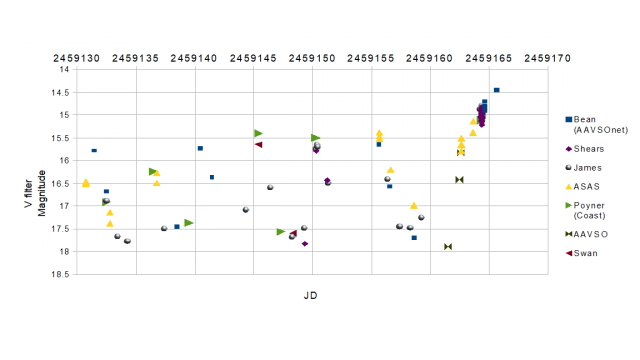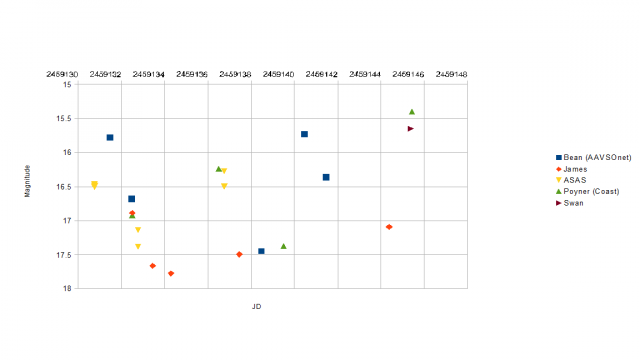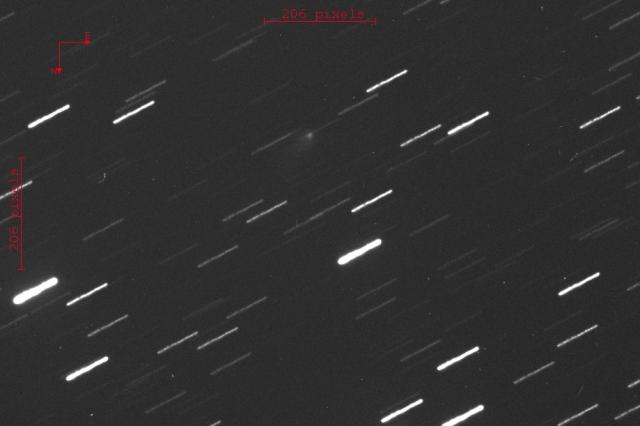Forum Replies Created
-
AuthorPosts
-
 Stewart John BeanParticipant
Stewart John BeanParticipantIX Dra has been interesting for a newcomer like myself. It changes every five days or so and puts in a bright superoutburst fairly regularly. Following IX Dra might be a good New Years resolution.
I am going to follow ( from my desk as I do not have my own telescope) other UGER stars that are high in the morning sky: ER Uma, RZ Lmi, and DI Uma and are starting their observing season. These are also evolving fast enough to be rewarding. Gary Poyner recommended RZ Lmi as it is a good winter target and it has a superoutburst every ~20 days so there really is something happening every few days.
Stewart
 Stewart John BeanParticipant
Stewart John BeanParticipantThe anticipated superoutburst has been detected. Superhumps are confirmed. I estimate the outburst started at 2459162.5 and should continue for another 10 days or so. I have updated the graph and hope it is fully inclusive for all those have contributed.
The timing of this superoutburst gives an average period for the last 8 outbursts of 59.5 days. This value is close to the last reported value of 58.5+-0.5 from 2010 and suggests that the super outburst period has not really changed in ten years. I will stick my neck out and suggest that the next outburst will start near January 7th.
I think this has been a worthwhile exercise and would wish to thank all who have contributed.
Regards
Stewart Bean

 Stewart John BeanParticipant
Stewart John BeanParticipantASAS-SN reports IX Dra at magnitude 15.6 in its green channel for 2459162.6 : so back to a high state. When in superoutburst ASAS-SN has recorded magnitudes in the 14.5 to 15 range.
The UK weather forecast seems a bit Novemberish with cloud on all days this week for Cambridgeshire. Fortunately, there is good weather forecast for the AAVSOnet SRO, Arizona telescope for the week ahead.
I’ll keep you posted.
Stewart
 Stewart John BeanParticipant
Stewart John BeanParticipantThe AAVSOnet SRO telescope in Arizona suggested a V mag of 17.7 last night – so a low state.
One week to 10 days to go before the super outburst.
Regards
Stewart
 Stewart John BeanParticipant
Stewart John BeanParticipantThe V filter observations graph below shows the current status as we approach an expected superoutburst in roughly two weeks time. With the frequency of observations achieved during this campaign, it should be possible to time the the superoutburst to within one day. This in turn should allow a fairly precise value for the superoutburst period to compare with literature values. The literature graph below implies a supercycle length of about 65 days for 2020 whilst TESS results, from 2019, suggest 61 days.

The observations below may not be complete so apologies in advance. Six normal outbursts at 5 day intervals have been recorded. The superoutburst is expected to reach 14.5 during November.
Thanks to all contributing.

 Stewart John BeanParticipant
Stewart John BeanParticipantToday I noticed the graphs had gone from my posts . I have put the latest back into the 26th Oct post. Any thoughts on the reasons? Are some formats preferred?
Nick James, Gary Poyner and David Swan all report IX Dra at fainter than 17 over the weekend. So back to its low state for a day or so. We can expect a few more normal outbursts at 4-5 day intervals before the super outburst around Nov 14th ( I’m sticking my neck out a bit here, I know).
Stewart
 Stewart John BeanParticipant
Stewart John BeanParticipant
 Thanks . That fits with the normal outbursts being about 5 days apart before a superoutburst. In the attachment from TESS data you can see the normal outbursts become more intense and 4-5 days separation. IX Dra never really goes into quiescence. Stewart
Thanks . That fits with the normal outbursts being about 5 days apart before a superoutburst. In the attachment from TESS data you can see the normal outbursts become more intense and 4-5 days separation. IX Dra never really goes into quiescence. Stewart Stewart John BeanParticipant
Stewart John BeanParticipantThe graph summaries the results to date.
There seem to have been three normal outbursts at 3-5 day intervals reaching 16.5 magnitude (V) at peak. The project is trying to time the next superoutburst to check the apparently regular 61+-2 day period suggested by TESS results. The next superoutburst is likely in the middle of November. If we can maintain observations at this frequency then we will have an uncertainly of only a day of two. Thanks to all observers who have contributed. Bean data is courtesy of AAVSOnet.
Stewart and Jeremy

 Stewart John BeanParticipant
Stewart John BeanParticipantI have the following for V1391 Cas from 23 Sept 2020:
V filter 12.95,
B filter 14.4 ,
I filter 10.19
Values are in the database. Stewart
 Stewart John BeanParticipant
Stewart John BeanParticipantHi, Just found this thread and wondered the current status?
I use the itelescope network and might consider joining a BAA group
Stewart
 Stewart John BeanParticipant
Stewart John BeanParticipantI make it 11.8 mag through V filter this morning, Aug 5th at 01 :43. (T18, Nerpio, Spain.)
I make it 11.1 mag through the R filter.
For both measurements the reference star was 11.2 on the AAVSO chart. I’ll try to get these uploaded via Muniwin once I get the hang of it.
 Stewart John BeanParticipant
Stewart John BeanParticipantI find the following from this morning using T5 (250 mm) in New Mexico at JD 2459062.902. I used AstroimageJ
With V filter, nova was 12.9 using 11.2 ,14.3, and 12.6, reference stars in AAVSO chart
With R filter, nova was 12.4 using 12.6 in AAVSO chart
With B filter, nova was 13.3 using 12.6 and 13.7 in AAVSO chart
Seems quite bright through the red filter. Stewart
 Stewart John BeanParticipant
Stewart John BeanParticipantI was not able to resolve the nova from its adjacent star in images taken overnight with the T18 scope in defocus mode for photometry. Not sure how to proceed. Stewart
 Stewart John BeanParticipant
Stewart John BeanParticipantI obtained this image using the T30 500 mm telescope at Siding Spring Observatory . It is the average of three 600 s exposures with a luminance filter.

 Stewart John BeanParticipant
Stewart John BeanParticipantHi,Here is a link to the arXiv website posting an abstract a paper on a Saturn sized planet discovered , in part, though citizen scientists. https://arxiv.org/abs/1909.09094
The first line of the abstract is reproduced below:
We report on the discovery and validation of TOI-813b (TIC 55525572 b), a transiting exoplanet identified by citizen scientists in data from NASA’s Transiting Exoplanet Survey Satellite (TESS) and the first planet discovered by the Planet Hunters TESS project.
I am one of many volunteers, probably including other BAA members, who found the light curve dip last winter. It is interesting that for transits that are infrequent ( this planet has an orbital period of about 80 days) , the automated searches are less able to detect the dip as they depend upon reoccurring events. So transits from hot Jupiters with short periods are easily found but cold Jupiters with long orbital periods are more difficult. So there is a role for volunteers even if you do not possess a telescope.
Regards
Stewart
 Stewart John BeanParticipant
Stewart John BeanParticipantHaving looked at the front page of the August journal , I am also struck by how coarse the material seems to be. Could the absence of fine dust be linked to the accumulation of charge on particles under the influence of the solar wind or deep UV? Electrostatic repulsion between individual particles and Bennu itself will be larger than the gravitational force for all but the larger particles assuming they both charge with the same polarity. So only big pieces can grow into something like Bennu.
In the outer solar system far from the solar wind charging will be much less significant and smaller particles can clump into a comet precursor.
Stewart
 Stewart John BeanParticipant
Stewart John BeanParticipantI obtained the following three results with the T5 telescope ( 250mm reflector) in New Mexico on 26 May. Using a 14.29 mag star as reference, AstroImageJ gives 15.55(V), 15.96(Red) and 15.48(Blue).
Stewart
 Stewart John BeanParticipant
Stewart John BeanParticipantAn image from New Mexico (T14) showing AL Com at the limit of detectability for 106 mm refractor with V filter. Still easily detected with a Luminance filter. Something for every section here with galaxies, a variable star, and a tumbling object crossing the 300s exposure field. A second image also captured this object suggesting it was not a CCD defect or other anomaly.
stewart

 Stewart John BeanParticipant
Stewart John BeanParticipantMike, How did you get to use this telescope? Stewart Bean
 Stewart John BeanParticipant
Stewart John BeanParticipantRepeating this field on May 5th ( following my first observation on 28 April), Al Com is only just detectable with itelescope’s T14 106 mm refractor with a V filter. AstroImageJ gives an magnitude estimate of 15.0 but the S/N and S/B are poor and the reference star is magnitude 11.9 – perhaps too bright to be the best choice.
However, using a Luminance filter it is still easily visible.
-
AuthorPosts
